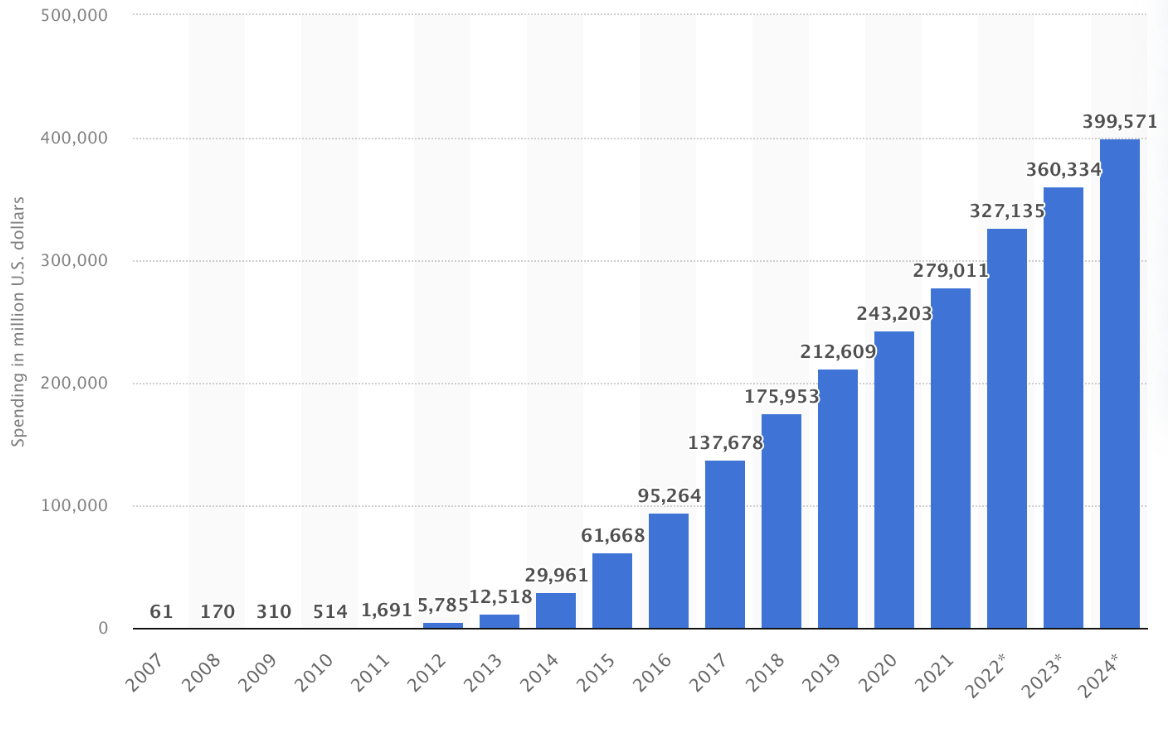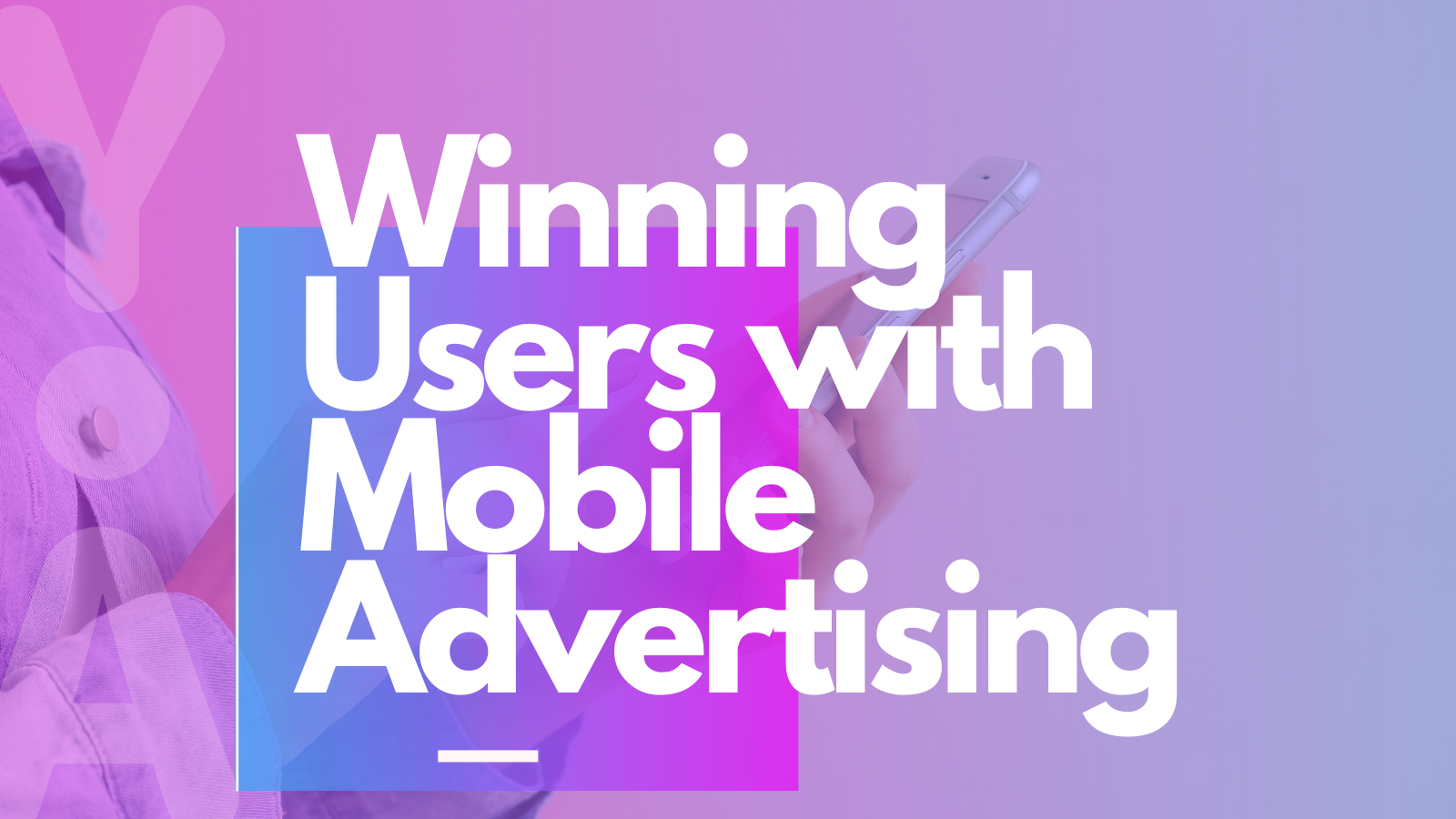Mobile devices such as smartphones and tablets have become integral tools for communication, news, entertainment and of course, advertising. In 2022, mobile advertising spending reached a record 327 billion dollars worldwide and is set to reach 400 billion by 2024.

|
Mobile advertising spending worldwide from 2007 to 2024 - Source: Statista
Here, we take a deeper look at the nuances between mobile advertising and mobile marketing and how technological innovations have paved the way for mobile advertising to flourish.
The Difference Between Mobile Advertising and Mobile Marketing
Although advertising and marketing are used interchangeably by many, there are vast differences between mobile advertising and mobile marketing. Mobile marketing is any advertising activity that promotes products and services via mobile devices. This form of marketing takes advantage of modern mobile technology features to customize marketing campaigns based on personal data. It uses technology to deliver personalized promotions of goods or services to smartphone or tablet users.
Mobile marketing encompasses the broad practice of marketing on mobile devices, which includes mobile advertising. On the other hand, mobile advertising is a paid methodology utilizing channels like in-app ads, banner ads, text ads, and rich media mobile ads. Mobile advertising refers to any form of advertising that appears on smartphones and other mobile devices. It includes all the interactive channels that are used by advertisers to communicate or promote brand information, news or offers, through mobile devices or networks.
This form of advertising includes anything from SMS offers, banner advertisements on websites, ads on downloaded apps and games, and more. The goal of mobile advertising is to ensure continuous engagement with users. In today’s multi channel media landscape, mobile advertising is one of the most effective methods to advertise.
Why Mobile Advertising?
There are over 5.22 billion smartphone users in the world. Sixty-six percent of the global population uses a mobile device. Because of this dramatic number of mobile users, it’s in the marketer's best interest to leverage mobile channels in order to win over the attention of their target audience.
This type of advertising also allows brands and advertisers to remain connected to customers whenever the user is on their device, with the average person spending 3 hours and 15 minutes on their phone each day. With traditional advertising, brands would only capture the attention of their target audience at certain television slots or on billboards at events. Mobile ads help brands to communicate with the customers both on the move and in the comfort of their own homes.
Benefits of Mobile Advertising
Targeting users with ads on their smartphones has many benefits. Mobile advertising is not only low cost and trackable, it also drives higher rates of conversion and offers a deeper level of personalization.
Low Cost
When compared with other methods of advertising, mobile advertising is a cost-effective choice. Print, TV, and billboards, for example, have significantly higher production and purchase costs. Creating ads for these other advertising platforms is also much more expensive than creating something digital for a mobile ad campaign. Additionally, because mobile advertising offers a variety of communication channels such as social media, email, SMS, etc, marketers can pick and choose the ones that fit their ad budget.
Trackable Results
Another major benefit of mobile advertising compared to traditional forms of advertising is that mobile ads are extremely trackable. App marketers can analyze and monitor analytics and data metrics such as impressions, click-through rate, likes, shares, audience demographics and more. Because of the transparency in data, marketers can take advantage of the information and iterate on their campaigns to maximize results.
Personalization
With mobile advertising, marketers can leverage personalization data such as location, time spent in-app, and other demographics such as age and gender. Personalization is an incredibly useful tool for capturing the attention of users. According to research, 7 out of 10 consumers prefer content and ads that are tailored to their personal interests. Mobile ads excel in this regard. Creating ads that are specific to users in certain locations will be more effective than those that are more generalized. Being able to selectively target audience segments increases the chance of user response and engagement with that particular advertisement.
Types of Mobile Advertising
There are many types of mobile ads, including push notifications, banner ads, interstitial ads, video and more.
- Push Notifications: Push notifications are the pop-ups that appear on a mobile device. They are delivered both while the user is active on the app and also when the user is not active as a way to re-engage them.
- Banner Ads: Banner ads are the most common type of mobile ads. They can be embedded on a website or served in-app. Banner ad formats include text ads, images, graphics or a mix of all three.
- Interstitial Ads: These ads are full-screen videos or graphics that are usually placed at app transition points. Interstitial ads may be displayed between activities or during the pause between levels in a mobile game.
- Video Ads: Video advertising is a powerful tool in a marketer’s toolkit. In 2022, online video ad spending amounted to almost 75 billion dollars and accounted for almost 30% of total display ad spend worldwide. Interactive mobile video advertising delivers a complete visual experience. This allows the user to feel closer to the product or service in question. Videos also capture the attention of users in a different way than static ads.
- Native Ads: Native ads are similar to banner ads but are displayed within the app’s natural environment so that they blend in and become less likely to be treated as advertisements. Users typically don’t see these ads as “spammy”.
Takeaways of Winning Users with Mobile Advertising
Mobile advertising spending reached a record 327 billion dollars worldwide last year and is set to reach 400 billion by 2024. In this blog, we take a deeper look at the nuances between mobile advertising and mobile marketing and how technological innovations have paved the way for mobile advertising to flourish.
Benefits of Mobile Advertising
- Low Cost: When compared with other methods of advertising, mobile advertising is a cost-effective choice. It also offers a variety of communication channels such as social media, email, SMS, etc, marketers can pick and choose the ones that fit their ad budget.
- Trackable Results: App marketers can analyze and monitor analytics and data metrics such as impressions, click-through rate, likes, shares, audience demographics and more.
- Personalization: With mobile advertising, marketers can leverage personalization data such as location, time spent in-app, and other demographics such as age and gender. Creating ads that are specific to users in certain locations will be more effective than those that are more generalized.




